It looks like you're using an Ad Blocker.
Please white-list or disable AboveTopSecret.com in your ad-blocking tool.
Thank you.
Some features of ATS will be disabled while you continue to use an ad-blocker.
share:
Explanation: For the purposes of this thread I will be refering to Iran as Samson and Zion as Delilah and I welcome the zionist shills in 3 ... 2 ...
1 ...
Hey there Delilah!
You're the whore of Babylon!
Babylonian captivity [wiki]
Swap 'client' for 'whore' in the above quoted context and my point becomes clear!
Whore of Babylon [wiki]
The Seven Hills of Jerusalem (By Ernest L. Martin, Ph.D., 2000, Reformatted by David Sielaff ) [askelm.com]
= ZION!
**********************************************************
Hail Samson!
So ... she wants you to take a nuclear power haircut!
Here is how to grow your hair even longer!
Let's look at your nuclear options ok!
The Samson Option [wiki]
Swap 'Israel' for 'Iran' in the above quoted context and my point becomes clear!
Now to technical details on how to do that best IMO!
mrbm = range
Hey there Delilah!
You're the whore of Babylon!
Babylonian captivity [wiki]
In the late 7th century BCE, the kingdom of Judah was a client state of the powerful Assyrian empire. In the last decades of the century Assyria was overthrown by Babylon, an Assyrian province with a history of former glory in its own right. Egypt, fearing the sudden rise of the Neo-Babylonian empire, seized control of Assyrian territory up to the Euphrates river in Syria, but Babylon counter-attacked and in the process Josiah, the king of Judah, was killed, although the circumstances are obscure (609 BCE). Judah became a Babylonian client, but in the following years two parties formed at the court in Jerusalem: one pro-Egyptian and the other pro-Babylonian.
Swap 'client' for 'whore' in the above quoted context and my point becomes clear!
Whore of Babylon [wiki]
Rev:chptr 17 verse 9:And here is the mind which hath wisdom. The seven heads are seven mountains, on which the woman sat. [King James Version; the New International Version Bible uses "hills" instead of "mountains"].
The Seven Hills of Jerusalem (By Ernest L. Martin, Ph.D., 2000, Reformatted by David Sielaff ) [askelm.com]
But strange as it may seem, the City of Jerusalem as it existed in the time of Christ Jesus was also reckoned to be the "City of Seven Hills." This fact was well recognized in Jewish circles. In the Pirke de-Rabbi Eliezer, an 8th century midrashic narrative (section 10), the writer mentioned without commentary (showing that the understanding was well known and required no defense) that "Jerusalem is situated on seven hills" (recorded in The Book of Legends, edited by Bialik and Ravnitzky, p. 371, paragraph 111). And, so it was. Those "seven hills" are easy to identify.
If one starts with the Mount of Olives just to the east of the main City of Jerusalem (but still reckoned to be located within the environs of Jerusalem), there are three summits to that Mount of Olives:
1] The northern summit (hill) is called Scopus [Hill One],
2] The middle summit (hill) was called Nob [Hill Two],
3] The highest point of Olivet itself, and the southern summit (hill) was called in the Holy Scriptures the "Mount of Corruption" or "Mount of Offence" [Hill Three] (II Kings 23:13).
4] On the middle ridge between the Kedron and the Tyropoeon Valleys there was (formerly) in the south "Mount Zion" [Hill Four] (the original "Mount Zion" and not the later southwest hill that was later called by that name),
5] The "Ophel Mount" [Hill Five],
6] To the north of that the "Rock" around which "Fort Antonia" was built [Hill Six],
7] And finally, there was the southwest hill itself [Hill Seven] that finally became known in the time of Simon the Hasmonean as the new "Mount Zion."
This makes "Seven Hills" in all.
Rev: chptr 17 verse 18: And the woman which thou sawest is that great city, which reigns over the kings of the earth .
= ZION!
**********************************************************
Hail Samson!
So ... she wants you to take a nuclear power haircut!
Here is how to grow your hair even longer!
Let's look at your nuclear options ok!
The Samson Option [wiki]
The Samson Option is a term used to describe Israel’s alleged deterrence strategy of massive retaliation with nuclear weapons as a “last resort” against nations whose military attacks threaten its existence, and possibly against other targets as well. Israel refuses to admit it has nuclear weapons or to describe how it would use them, an official policy of nuclear ambiguity, also known as "nuclear opacity." This has made it difficult for anyone outside the Israeli government to definitively describe its true nuclear policy, while still allowing Israel to influence the perceptions, strategies and actions of other governments.
Swap 'Israel' for 'Iran' in the above quoted context and my point becomes clear!
Now to technical details on how to do that best IMO!
mrbm = range
reply to post by OmegaLogos
Explantion: Continued from above post.
tamper = polyethylene + water + depleted uranium [both freely available + waste product from centrifuge process]
Neutron Radiation [wiki]
Uranium - 238 [wiki]
How much uranium does a reactor use per year?
Reactors [world-nuclear.orgs]
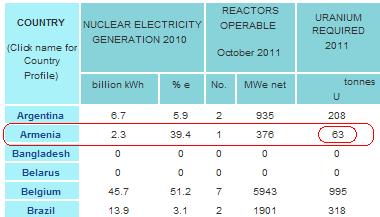
= 65tons [aprox]
super critical mass required for bomb = 65kg [0.1% of the above total]
enrichment = 90% + [takes about 2yrs/10000+hrs]
Centrifuge [wiki]
Iran's Nuclear Timetable (Updated November 2, 2011) [iranwatch.org]
Personal Disclosure: Continued next post!
Explantion: Continued from above post.
tamper = polyethylene + water + depleted uranium [both freely available + waste product from centrifuge process]
Neutron Radiation [wiki]
Neutron radiation protection relies on radiation shielding. In comparison with conventional ionizing radiation based on photons or charged particles, neutrons are repeatedly bounced and slowed (absorbed) by light nuclei, so a large mass of hydrogen-rich material is needed. Neutrons readily pass through most material, but interact enough to cause biological damage. Due to the high kinetic energy of neutrons, this radiation is considered to be the most severe and dangerous radiation available. The most effective materials are e.g. water, polyethylene, paraffin wax, or concrete, where a considerable amount of water molecules are chemically bound to the cement. The light atoms serve to slow down the neutrons by elastic scattering, so they can then be absorbed by nuclear reactions. However, gamma radiation is often produced in such reactions, so additional shielding has to be provided to absorb it.
Uses of DU take advantage of its very high density of 19.1 g/cm3 (68.4% denser than lead).
Most depleted uranium arises as a byproduct of the production of enriched uranium for use in nuclear reactors and in the manufacture of nuclear weapons. Enrichment processes generate from the uranium feed a small fraction of uranium with a higher-than-natural concentration of lower-mass uranium isotopes (in particular U-235, which is the uranium isotope supporting the fission chain reaction) with the bulk of the feed ending up as depleted uranium, in some cases with mass fractions of U-235 and U-234 less than a third of those in natural uranium.
Uranium - 238 [wiki]
Uranium-238 (238U or U-238) is the most common isotope of uranium found in nature. It is not fissile, but is a fertile material: it can capture a slow neutron and after two beta decays become fissile plutonium-239. 238U is fissionable by fast neutrons, but cannot support a chain reaction because inelastic scattering reduces neutron energy below the range where fast fission is probable.
How much uranium does a reactor use per year?
Reactors [world-nuclear.orgs]

= 65tons [aprox]
super critical mass required for bomb = 65kg [0.1% of the above total]
enrichment = 90% + [takes about 2yrs/10000+hrs]
Centrifuge [wiki]
Gas centrifuges are used in uranium enrichment. The heavier isotope of uranium (uranium-238) in the uranium hexafluoride gas tends to concentrate at the walls of the centrifuge as it spins, while the desired uranium-235 isotope is extracted and concentrated with a scoop selectively placed inside the centrifuge. It takes many thousands of centrifuges to enrich uranium enough for use in a nuclear reactor (around 3.5% enrichment), and many thousands more to enrich it to weapons-grade (above 90% enrichment) for use in nuclear weapons.
Iran's Nuclear Timetable (Updated November 2, 2011) [iranwatch.org]
Iran's progress towards this status is estimateda below. These estimates are based upon the theoretical performance of Iran’s existing centrifuges and upon how these centrifuges appear to have performed in the past:
Bomb potential of Iran’s low-enriched uranium stockpile
•Amount of U-235 contained in Iran’s stockpile of low-enriched uranium:
110 kg b
•Amount of this U-235 produced each month:
3.43 kg c
•Amount of this U-235 required to fuel a first-generation implosion bombd:
21.6 kg e
•Date by which Iran probably had stockpiled the above:
December 2008 f
•Number of additional months needed to convert this low-enriched uranium to weapon-grade g:
From 3 to 12 h
•Date by which Iran probably had enough U-235 to fuel a second bomb:
December 2009 i
•Date by which Iran probably had enough U-235 to fuel a third bomb:
August 2010 j
•Date by which Iran probably had enough U-235 to fuel a fourth bomb:
April 2011 bb
Personal Disclosure: Continued next post!
edit on 11-11-2011 by OmegaLogos because: Edited to update from reserved status.
reply to post by OmegaLogos
Explantion: Continued from above post!
The Iranian Gas Centrifuge Uranium Enrichment Plant at Natanz: Drawing from Commercial Satellite Images (By David Albright and Corey Hinderstein The Institute for Science and International Security (ISIS) March 14, 2003) [isis-online.org]
Stuxnet attack on Iran nuclear program came about a year ago, report says (By Mark Clayton, Staff writer / January 3, 2011) [csmonitor.com]
Damage = 15Kt [for comparision Little Boy [wiki] ]
Resulting in ...
Target: Dome of the Rock Jerusalem Israel/West Bank

Blast FX!
HYDESim (The data used in HYDESim are based on information found in "The Effects of Nuclear Weapons", 3rd Edition, by Samuel Glasstone and Philip J. Dolan.) [meyerweb.com]
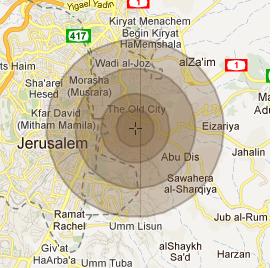
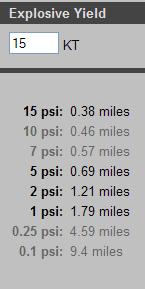
Firestorm FX!
Firestorms simulator (these simulations are based on information found in "The Effects of Nuclear Weapons", 3rd Edition, by Samuel Glasstone and Philip J. Dolan.) [nucleardarkness.org]
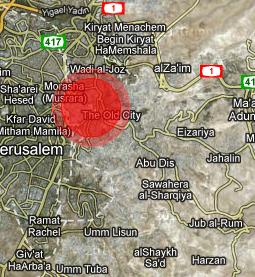


Fallout FX!
What are Israel's prevailing winds (First answer by ID0779402963. Last edit by ID0779402963. Question popularity: 13) [wiki.answers.com]
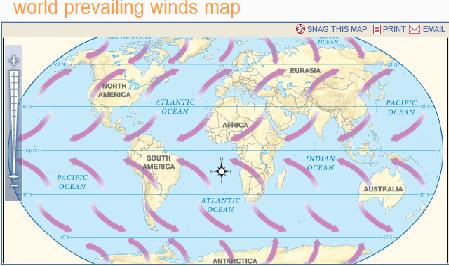
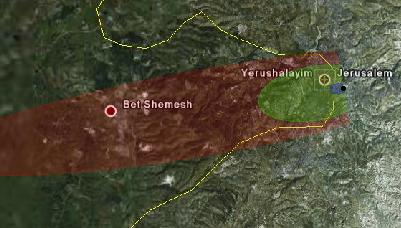

Personal Disclosure: Pls move to skunk works if too speculative ok!
Explantion: Continued from above post!
Moving from low-enriched to weapon-grade uranium
•Amount of uranium hexafluoride (UF6) enriched to 3.5 percent U-235 now on hand:
4,628 kg k
•Average daily production rate of this low-enriched UF6:
4.76 kg l
•Amount of this low-enriched UF6 needed to produce a bomb’s worth of weapon-grade UF6:
914 kg m
•Number of separative work units (SWUs)n needed to accomplish the above:
840 o
•Approximate number of first generation IR-1 centrifuges being fed with UF6 at the Natanz Fuel Enrichment Plant, as of the last reported visit by IAEA inspectors:
5,860 p
•Average number of SWUs each centrifuge appears to have produced over the past four months:
.74 q
•Number of months needed for these 5,860 centrifuges operating at such a capacity to produce the 840 SWUs theoretically needed to fuel a bomb:
2.3 cc
•Approximate number of centrifuges installed at Natanz as of the last reported visit by IAEA inspectors:
8,000 r
•Number of SWUs these 8,000 centrifuges could produce per year, based on their recent rate of production:
6,000 s
•Number of months needed for these 8,000 centrifuges operating at such a capacity to produce the 840 SWUs theoretically needed to fuel a bomb:
1.5 t
•Approximate amount of uranium hexafluoride (UF6) enriched to research reactor grade (approximately 20 percent U-235) on hand as of August 20, 2011:
70.8 kg u
•Number of first generation IR-1 centrifuges being fed with UF6 at the Natanz pilot plant as of the last reported visit by IAEA inspectors:
328 v
•Average monthly production rate of this UF6:
4.7 kg w
•Amount of this 20 percent enriched UF6 theoretically needed to produce a bomb’s worth of weapon-grade UF6:
120 kg x
•Date by which Iran could produce this 120 kg, assuming its present rate of production:
June 2012 dd
•Number of SWUs needed to accomplish this enrichment to weapon-grade:
260 y
•Number of months theoretically needed for the 328 centrifuges, operating at their present capacity, to accomplish the above:
12 z
•Number of months theoretically needed to accomplish the enrichment to weapon-grade if the number of centrifuges devoted to production were doubled (to 656), tripled (to 984), or quadrupled (to 1,312): aa
doubled: 6 months
tripled: 4 months
quadrupled: 3 months
Number of centrifuges deployed over time
Date of IAEA inventory . Centrifuges being fed with UF6 . Other centrifuges (installed or being installed)
11/5/2010 .............................. 4,816 ................................. 3,610
The Iranian Gas Centrifuge Uranium Enrichment Plant at Natanz: Drawing from Commercial Satellite Images (By David Albright and Corey Hinderstein The Institute for Science and International Security (ISIS) March 14, 2003) [isis-online.org]
The pilot centrifuge plant contained about 160 centrifuges operating in a cascade when senior IAEA officials visited the site on February 21, 2003. No uranium, however, was in any of the centrifuges at this site when these IAEA officials visited. The IAEA officials also saw components for another 1000 centrifuges in these buildings.
Recent media reports have stated that Natanz is intended to house only 5,000 centrifuges. This number may reflect an interim goal for this site, perhaps the capacity Iran wants to achieve in the next few years.
Stuxnet attack on Iran nuclear program came about a year ago, report says (By Mark Clayton, Staff writer / January 3, 2011) [csmonitor.com]
Everything appeared to be going well for the Iranian program up through Nov. 16, 2009, the date of a quarterly report by International Atomic Energy Agency inspectors. At that point, there had been a "steady increase in the number of centrifuges" at Iran's Natanz plant, reaching a peak of 8,692 installed centrifuges.
But by Feb. 18, 2010, the quarterly reports issued by IAEA inspectors began registering problems there, according to a little-noticed analysis by the Institute for Science and International Security (ISIS), released Dec. 23. By then, Iran had pulled the plug on about 1,000 centrifuges it had previously installed, ISIS concluded.
Damage = 15Kt [for comparision Little Boy [wiki] ]
The Mk I "Little Boy" was 120 inches (300 cm) in length, 28 inches (71 cm) in diameter and weighed approximately 9,700 pounds (4,400 kg). The design used the gun method to explosively force a hollow sub-critical mass of uranium-235 and a solid target cylinder together into a super-critical mass, initiating a nuclear chain reaction. This was accomplished by shooting one piece of the uranium onto the other by means of chemical explosives. It contained 64 kg (140 lb) of uranium, of which less than a kilogram underwent nuclear fission, and of this mass only 0.6 g (0.021 oz) was transformed into energy.
The main objective of Little Boy was to create a weapon that was absolutely guaranteed to work.
It has been estimated that 130,000 to 150,000 persons had died by the end of December 1945.
Resulting in ...
Target: Dome of the Rock Jerusalem Israel/West Bank

Blast FX!
HYDESim (The data used in HYDESim are based on information found in "The Effects of Nuclear Weapons", 3rd Edition, by Samuel Glasstone and Philip J. Dolan.) [meyerweb.com]


Overpressure Key
15 psi Complete destruction of reinforced concrete structures, such as skyscrapers, will occur within this ring. Between 7 psi and 15 psi, there will be severe to total damage to these types of structures.
7 psi Severe damage to complete destruction of reinforced concrete structures, such as skyscrapers, will occur within this ring.
5 psi Complete destruction of ordinary houses, and moderate to severe damage to reinforced concrete structures, will occur within this ring.
2 psi Severe damage to ordinary houses, and light to moderate damage to reinforced concrete structures, will occur within this ring.
1 psi Light damage to all structures, and light to moderate damage to ordinary houses, will occur within this ring.
0.25 psi Most glass surfaces, such as windows, will shatter within this ring, some with enough force to cause injury.
Firestorm FX!
Firestorms simulator (these simulations are based on information found in "The Effects of Nuclear Weapons", 3rd Edition, by Samuel Glasstone and Philip J. Dolan.) [nucleardarkness.org]



Fallout FX!
What are Israel's prevailing winds (First answer by ID0779402963. Last edit by ID0779402963. Question popularity: 13) [wiki.answers.com]
Israel is located at the exact point where these four weather systems converge. This is why the country is subject to contradictory weather patterns (rainy or dry) as well as highly unpredictable shifts in the direction of prevailing winds. These unusual climatic conditions make it very difficult to predict weather conditions.



Personal Disclosure: Pls move to skunk works if too speculative ok!
edit on 11-11-2011 by OmegaLogos because: Edited to update from reserved status.
Now this is what I call a thread! Looks like you put a lot of work into it.
Sure is an interesting read so far.
Sure is an interesting read so far.
SnF for such a great read. Nice thread nice. Liked what you did with the name swapping, makes you think.
reply to post by Corruption Exposed
And ...
reply to post by Dembow
Explanation: Thanks for the bumps! St*rred for both of you!
Personal Disclosure: Bumping this for shameless self promotion!
P.S. I have more info but OL will keep his powder and shot dry for another bump later on!
And ...
reply to post by Dembow
Explanation: Thanks for the bumps! St*rred for both of you!
Personal Disclosure: Bumping this for shameless self promotion!
P.S. I have more info but OL will keep his powder and shot dry for another bump later on!
great thread OL it would seem that WWI & WWII never stopped. the powers funding the wars only stopped to let their their super weapons mature into a
WW0.
why wait till now? and who will strike first?
why wait till now? and who will strike first?
As sick as it sounds I wish I could actually watch ALL the chess pieces being played.
You should have avoided the quoting revelations etc in the beginning of your thread. you sort of blew all academic credibility.
reply to post by daggyz
The bad guys like to reverse roles. Hence, the Romans renamed Judea to "Palestina" after the Jews historical biblical nemesis, the Philistines (Plishtim in Hebrew) and so today we have Arabs masquerading as the original inhabitants of the land when in reality the majority of those Arabs are from Lebanon, Syria, Jordan, Egypt, coming in the late 19th century with Mohammadi Alis conquests of Palestine, and again later on after the Zionists began settling in the north-eastern portion of Israel (Tel-Aviv, Jaffa, Haifa region) and this is actually found in Syrian and British mandate documents; yet astonishingly, the enemies of Israel ignore this poignant information.
The bad guys like to reverse roles. Hence, the Romans renamed Judea to "Palestina" after the Jews historical biblical nemesis, the Philistines (Plishtim in Hebrew) and so today we have Arabs masquerading as the original inhabitants of the land when in reality the majority of those Arabs are from Lebanon, Syria, Jordan, Egypt, coming in the late 19th century with Mohammadi Alis conquests of Palestine, and again later on after the Zionists began settling in the north-eastern portion of Israel (Tel-Aviv, Jaffa, Haifa region) and this is actually found in Syrian and British mandate documents; yet astonishingly, the enemies of Israel ignore this poignant information.
Well now... Arn't U just a... now "I" can take my 8-) 'Authority LKing Glasses off John 9'...
& now U can... ALL^SEE... the LIGHT ... HOLD PLEASE... while "I" poor me some Bio-Dynamic wine into my Chalice... & raise U a toast ... Ass this is turning out to SIRIUS---(a)... GREAT 3rd EYE OPENING DAY ... Let me give U a tasty treat... made fresh every day from my private reserves... with my very own mini 'Manna Fortune Cookie Machine'...
(|)... Here... let me crack it open for U... since this is just a reduX that U already knew ... Type 'O' civilization looKey... What do we have written on the little prayer note inside... It RV reads Isaiah 8:14 & Isaiah 24:18 ... Could it SIRIUS---(b)... That Gaia herself... is really the 'Mystery Galactic Whore'
Mr X-ULTRA//MIB//STAR//WARS... saying... GOOD JOB from my TR-3B(classified model#) ...
Now imaGin what U don't know ... like the... lasers that will blow anything... just as the sparks come out the end of the silO... O! did "I" mention... the 'Magnetic Propulsion Stealth ICBM's' that may already be in place for a 'Suprise First Strike Party'... that may (b) just hidding around the Jordan mount Nebo... Have a happy & safe night... & and don't let the little Grays tickle Ur mind... Unless you want Ur soul to come out and play of course
& now U can... ALL^SEE... the LIGHT ... HOLD PLEASE... while "I" poor me some Bio-Dynamic wine into my Chalice... & raise U a toast ... Ass this is turning out to SIRIUS---(a)... GREAT 3rd EYE OPENING DAY ... Let me give U a tasty treat... made fresh every day from my private reserves... with my very own mini 'Manna Fortune Cookie Machine'...
(|)... Here... let me crack it open for U... since this is just a reduX that U already knew ... Type 'O' civilization looKey... What do we have written on the little prayer note inside... It RV reads Isaiah 8:14 & Isaiah 24:18 ... Could it SIRIUS---(b)... That Gaia herself... is really the 'Mystery Galactic Whore'
Mr X-ULTRA//MIB//STAR//WARS... saying... GOOD JOB from my TR-3B(classified model#) ...
Now imaGin what U don't know ... like the... lasers that will blow anything... just as the sparks come out the end of the silO... O! did "I" mention... the 'Magnetic Propulsion Stealth ICBM's' that may already be in place for a 'Suprise First Strike Party'... that may (b) just hidding around the Jordan mount Nebo... Have a happy & safe night... & and don't let the little Grays tickle Ur mind... Unless you want Ur soul to come out and play of course
edit on 11-11-2011 by CosmicWaterGate because: CME glitch... Wasen't me
edit on 11-11-2011 by
CosmicWaterGate because: 'that may' is another way of saying "Allegedly"
Originally posted by dontreally
reply to post by daggyz
The bad guys like to reverse roles. Hence, the Romans renamed Judea to "Palestina" after the Jews historical biblical nemesis, the Philistines (Plishtim in Hebrew) and so today we have Arabs masquerading as the original inhabitants of the land when in reality the majority of those Arabs are from Lebanon, Syria, Jordan, Egypt, coming in the late 19th century with Mohammadi Alis conquests of Palestine, and again later on after the Zionists began settling in the north-eastern portion of Israel (Tel-Aviv, Jaffa, Haifa region) and this is actually found in Syrian and British mandate documents; yet astonishingly, the enemies of Israel ignore this poignant information.
And many of the Jews in Israel are NOT genetically linked to the land they claim as their own..
So your point is.
reply to post by daggyz
Explanation: Thanks for taking the bait!
Personal Disclosure: Pls stay on topic!
reply to post by dontreally
Explanation: ...
It was unavoidable due to being a longstanding environmental hotbed of religious animosity!
So best to take it full on, head on and at speed!
Personal Disclosure:
And as if I care about that!
Explanation: Thanks for taking the bait!
Explanation: For the purposes of this thread I will be refering to Iran as Samson and Zion as Delilah and I welcome the zionist shills in 3 ... 2 ... 1 ...
Except that Samson was a Hebrew.
Personal Disclosure: Pls stay on topic!
reply to post by dontreally
Explanation: ...
You should have avoided the quoting revelations etc in the beginning of your thread.
It was unavoidable due to being a longstanding environmental hotbed of religious animosity!
So best to take it full on, head on and at speed!
Personal Disclosure:
you sort of blew all academic credibility.
And as if I care about that!
reply to post by ipleadthe5th
Explanation: St*rred!
Here is some evidence that might support that ...
Pre Flood ...
Adam and Eve were created in the Garden of Eden which is classically and historically and religiously believed to have been in Babylon!
Garden of Eden [wiki]
Post Flood ... Abram/Abraham was a Babylonian!
Abraham [wiki]
Ancient Civilizations [uncp.edu]
Aram-Naharaim [wiki]
Personal Disclosure: And Samson's origins who was from the tribe of Dan might not be so kosher either as ...
Samson [wiki]
Cont. next pst
Explanation: St*rred!
Here is some evidence that might support that ...
Pre Flood ...
Adam and Eve were created in the Garden of Eden which is classically and historically and religiously believed to have been in Babylon!
Garden of Eden [wiki]
The Book of Genesis does not state a physical geographic location for the garden of Eden, but ideally it is "the garden of God" or divine home (Ezek 31:8-9). Also, according to some ancient myths, all of the world's major rivers flow out of the divine home. Genesis 2:10-14 names the garden of Eden as the source of four rivers, the Tigris and Euphrates, great waterways of Mesopotamia, and the Pishon and Gihon. Four waterways were possibly cited because in ancient times, similar to today, the world was charted in four different directions, North, South, East and West.
Post Flood ... Abram/Abraham was a Babylonian!
Abraham [wiki]
Birth of Abraham
Terah, the tenth in descent from Noah, fathered Abram, Nahor and Haran, and Haran fathered Lot. Haran died in his native Ur of the Chaldees, and Abram married Sarai, who was barren. Terah, with Abram, Sarai and Lot, then departed for Canaan, but settled in a place named Haran, where Terah died at the age of 205. (Genesis 11:27-11:32)
Ancient Civilizations [uncp.edu]
The Era of Invasions, ca 1750-1600 BC
During this period, we find two major groups of invaders. 1) the Semites, peoples from the Arabian desert who migrated into Northern Mesopotamia, Syria, Palestine, and Egypt; 2) the Indo-Europeans, or the Ayrians—the same peoples who crossed into India about 1800BC—
Hebrew Civilization, ca 1800 BC-AD 135
From this most important of the ancient Near Eastern peoples, Western Civilization has inherited, among other things: 1) historical background to Christianity, 2) concept of universal monotheism, 3) idea of ethical monotheism (i.e. the concept of a transcendent God as a moral law-giver and judge), and 4) a sacred text (the Old Testament).
The history of the Hebrew people can be divided into periods.
1) Origins (1950BC-1020 BC): It begins with their migration, perhaps after 1950BC, under the leadership of Abraham to Palestine from their probable place of origin in the Arabian desert to Moses (ca. 1400BC).
Aram-Naharaim [wiki]
Aram-Naharaim is a region that is mentioned five times in the Hebrew Bible. It is commonly identified with Nahrima mentioned in three tablets of the Amarna correspondence as a geographical description of the kingdom of Mitanni. In Genesis, it is used somewhat interchangeably with the names Paddan Aram and Haran to denote the place where Abraham settled with his father Terah's family after leaving Ur of the Chaldees, while en route to Canaan (Gen. 11:31), and the place to which later patriarchs returned for marriage. Paddan Aram refers to the part of Aram-Naharaim along the upper Euphrates, while Haran is mainly identified with the ancient city of Harran on the Balikh River. According to one rabbinical Jewish tradition, the birthplace of Abraham (Ur) was also situated in Aram-Naharaim.
Personal Disclosure: And Samson's origins who was from the tribe of Dan might not be so kosher either as ...
Samson [wiki]
Some biblical scholars suggest that Samson's home tribe of Dan might have been related to the Philistines themselves. "Dan" might be another name for the tribe of Sea Peoples otherwise known as the Denyen, Danuna, or Danaans. If so, then Samson's origin might be entirely Aegean. These speculations are in stark contrast to the historical depictions expressed in the Bible and are therefore mutually exclusive.
Cont. next pst
reply to post by OmegaLogos
Explanation: Continued from above post ...
Zorah [wiki]
Brook of Sorek [wiki]
Personal Disclosure: Seems Samson may of been having a local dispute with the tribe of Judah!
Explanation: Continued from above post ...
Joan Comay, co-author of Who's Who in the Bible: The Old Testament and the Apocrypha, The New Testament, believes that the biblical story of Samson is so specific concerning time and place that Samson was undoubtedly a real person who pitted his great strength against the oppressors of Israel.[2]
In contrast, James King West finds that the hostilities between the Philistines and Hebrews appear to be of a "purely personal and local sort". He also finds that Samson stories have, in contrast to much of Judges, an "almost total lack of a religious or moral tone".
Zorah [wiki]
In Joshua 19:41, Zorah is mentioned in the allotment of the Tribe of Judah, on the border with the Tribe of Dan. It was most likely the Danites that occupied Zorah Judges 18:2, probably the same as Zoreah (Joshua 15:33). This was Samson's birthplace (Judges 13:2), and near it he found a grave (Judges 16:31).
Zorah (Hebrew: צרעה) or Tzorah, perhaps "place of wasps," was a biblical town in the low country of Judah.
Brook of Sorek [wiki]
Nahal Sorek (Hebrew: נחל שורק, lit. Brook of Sorek), also Soreq, is one of the largest, most important drainage basins in the Judean Hills.[1] It is mentioned in the Book of Judges 16:4 of the Bible as the border between the ancient Philistines and the Tribe of Dan of the ancient Israelites. It is known in Arabic as Wadi Surar.
Biblical historyNahal Sorek was the place where Delilah lived, and Samson came to meet her for the first time. It was also the place she enticed him to tell her the secret of his strength, and where he was eventually captured by the Philistines:
“ And Samson went to Gaza... And it came to pass afterward, that he loved a woman in the brook/valley of Sorek, whose name was Delilah. And the lords of the Philistines came up to her, and said to her: 'Entice him, and see wherein his great strength lies, and by what means we may prevail against him, that we may bind him to afflict him... ”
Personal Disclosure: Seems Samson may of been having a local dispute with the tribe of Judah!
reply to post by dontreally
"The enemies of Israel"
Tell me, is there any country that Israel actually considers friends.??
If so please name them..
Israel even bag the US and it's leaders regularly..
yet astonishingly, the enemies of Israel ignore this poignant information.
"The enemies of Israel"
Tell me, is there any country that Israel actually considers friends.??
If so please name them..
Israel even bag the US and it's leaders regularly..
reply to post by ipleadthe5th
umm, yes they are. Most of the genetic tests done have shown that Ashkenazi Jewry is related to both Sephardic Jewry and Persian/Mizrahic Jewry, and all three groups derive from the levant.
And yet anti-Semites will always claim "zionist propaganda" as a reason for dismissing this evidence.
en.wikipedia.org...
umm, yes they are. Most of the genetic tests done have shown that Ashkenazi Jewry is related to both Sephardic Jewry and Persian/Mizrahic Jewry, and all three groups derive from the levant.
And yet anti-Semites will always claim "zionist propaganda" as a reason for dismissing this evidence.
en.wikipedia.org...
Originally posted by dontreally
reply to post by ipleadthe5th
umm, yes they are. Most of the genetic tests done have shown that Ashkenazi Jewry is related to both Sephardic Jewry and Persian/Mizrahic Jewry, and all three groups derive from the levant.
And yet anti-Semites will always claim "zionist propaganda" as a reason for dismissing this evidence.
en.wikipedia.org...
Nothing in your link tells me what percentage of Jews in Israel are genetically linked back to ancient Israel..
Another one playing the "anti-semites" card huh??
How yesterday and boring.
new topics
-
Ukraine halts transit of Russian gas to Europe after a prewar deal expired
Political Conspiracies: 1 hours ago -
Welp...Happy New Year!!
General Chit Chat: 3 hours ago -
Vehicle Strikes people in New Orleans
Mainstream News: 5 hours ago -
The Hand that Rocks the Cradle - Labour Plans “diversities of our society” Curriculum Change
Regional Politics: 5 hours ago
top topics
-
Vehicle Strikes people in New Orleans
Mainstream News: 5 hours ago, 16 flags -
The Hand that Rocks the Cradle - Labour Plans “diversities of our society” Curriculum Change
Regional Politics: 5 hours ago, 5 flags -
SCOTUS Chief Justice JOHN ROBERTS Ends 2024 Describing His Fears for Safety of U.S. Judges.
Above Politics: 14 hours ago, 4 flags -
Welp...Happy New Year!!
General Chit Chat: 3 hours ago, 3 flags -
Ukraine halts transit of Russian gas to Europe after a prewar deal expired
Political Conspiracies: 1 hours ago, 3 flags
active topics
-
Ukraine halts transit of Russian gas to Europe after a prewar deal expired
Political Conspiracies • 30 • : KrustyKrab -
The Hand that Rocks the Cradle - Labour Plans “diversities of our society” Curriculum Change
Regional Politics • 12 • : Flyingclaydisk -
Vehicle Strikes people in New Orleans
Mainstream News • 37 • : BernnieJGato -
President Carter has passed
Mainstream News • 37 • : andy06shake -
I dont understand what i just witnessed
Social Issues and Civil Unrest • 24 • : canadiandw -
New UK Petition - Close the borders! Suspend ALL immigration for 5 years!
Regional Politics • 19 • : gortex -
The C.D.C. Says There Was NO INFLUENZA Worth Reporting for the 2020-2021 Flu Season.
Diseases and Pandemics • 86 • : KrustyKrab -
Welp...Happy New Year!!
General Chit Chat • 7 • : nugget1 -
US disburses $3.4 billion in budget aid for Ukraine, Yellen says
US Political Madness • 21 • : xuenchen -
How we've changed in 100 years
Ancient & Lost Civilizations • 16 • : SprocketUK









